Cussonia spicata
Cussonia spicata Thunb.
Family: Araliaceae
Common names: cabbage-tree, common cabbage tree; kiepersol (Afr); umsenge(S, Z & Xh.); motshetshe (NS)
SA Tree No: 564
Introduction
The cabbage-tree is a strikingly beautiful garden tree which is widely cultivated both locally and abroad for its striking evergreen foliage. Its unusual form makes it a feature in the garden as well as in its natural habitat. The genus Cussonia as a whole is less well known to horticulture, despite the fact that it hosts numerous very attractive species from dwarf to very large trees.
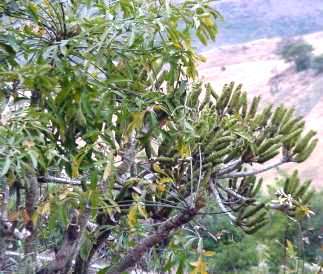
Description
Description
The cabbage-tree is an attractive, quick growing, relatively long lived tree which can attain a height of 15m. Cussonias in general have the peculiar habit of producing their attractive leaves toward the ends of thick branches in large round heads. Trees typically have between 1 - 15 such heads, although older specimens may develop many more.
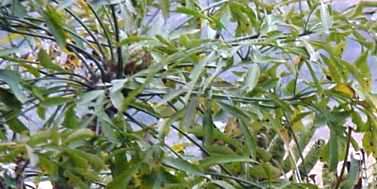
Distribution and habitat
Distribution description
Cussonia spicata occurs naturally over a wide range in the wetter areas of southern Africa from the southern Cape and eastern parts of the country extending through Mozambique, Zimbabwe, Zambia and further north reaching into tropical Africa.
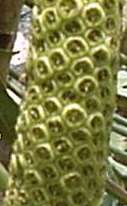
The species is variable depending on origin, some forms being more frost tolerant than others. The more resistant forms may tolerate a moderate degree of frost but will require protection when young. Other forms which originate in sub-tropical areas on the KwaZulu-Natal & Eastern Cape coast will not tolerate even a mild degree of frost. The species enjoys ample water, full sun or semi shade, especially when young.
Derivation of name and historical aspects
History
The name Cussonia is named after the Professor of Botany at the University of Montpellier. Prof. Pierre Cusson. (1727 - 1783). The specific name spicata means spike-like in reference to the arrangement of the flowers.
The genus Cussonia is represented by eleven different species in South Africa; most are small to medium trees. C.paniculata is also sometimes to be found in gardens. The genus is small and occurs in Africa and the Mascarene islands.
It belongs to a large family Araliaceae,to which well known plants such as Ginseng, Ivy, and several indoor plants, as well as Tetrapanax papyriferus, the plant used to make chinese rice paper, belong. This family is also closely related to the parsley family (Apiacae) which includes several popular vegetables and herbs such as carrots, fennel & parsley.
Uses
Use
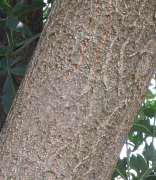
In addition to its popularity as a decorative garden tree and useful accent plant, the leaves of C. spicata are traditionally used as a treatment for indigestion. The wood is very soft and decays easily and is used to make mole traps. There are also reports that the soft wood of the Highveld cabbage-tree (Cussonia paniculata) was used to make brake blocks for ox-wagons.
The roots are succulent and edible, mashed roots have also been used in the treatment of Malaria.
Growing Cussonia spicata
Grow
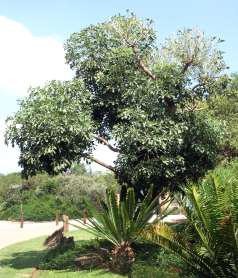
The cabbage- tree is relatively easily cultivated, but does not tolerate extreme degrees of frost. The seed should be harvested and sown fresh. Wash the thin layer of pulp off the seed and sow immediately into seed trays in a fine seedling germination mixture. Cover lightly. Seed may take from three to eight weeks to germinate depending on the species. Seedlings are best left in the tray for the first year and transplanted into individual containers at the beginning of the second growing season.
Saplings respond well to horticultural fertilizers, they can grow quickly and may be ready to be planted into the ground after 3 to five years in the nursery. When planting out, trees respond well to a well-prepared hole with plenty of compost and bonemeal mixed with the soil.
Due to their strong architectural form they are very useful as focal points in the landscape, they may also be used to good effect in containers while they are still young. Cussonias are sometimes prone to attack by psylla; a small insects that causes pimple like growths on the leaves, causing the leaves to be distorted and become unsightly. This can be controlled with the use of a systemic insecticide.
References
- COATES PALGRAVE, M. 2002. Keith Coates Palgrave Trees of southern Africa, edn 3. Struilk: Cape town.
- Germishuizen, G. & Meyer, N.L. (eds) 2003. Plants of Southern Africa: an annotated checklist. Strelitzia 14. National Botanical Institute, Pretoria.
- JOFFE, P. 2001. Creative Gardening with Indigenous Plants, a South African guide. Briza Publications: Pretoria.
- PALMER, E. & PITMAN, N. 1972 Trees of Southern Africa Vol III.A.A. Balkema: Cape Town.
- POOLEY. E 1993. The complete field guide to Trees of Natal, Zululand & Transkei. Natal Flora Publications Trust: Durban.
- SCHMIDT, E., LÖTTER, M. & Mc CLELAND, W. 2002. Trees and Shrubs of Mpumalanga and Kruger National Park. Johannesburg: Jacana.
- VENTER, F & VENTER, J. 1985 Making the Most of Indigenous Trees. Briza Publications: Pretoria.
Credits
Andrew Hankey
Walter Sisulu National Botanical Garden
December 2004
Plant Attributes:
Plant Type: Tree
SA Distribution: Eastern Cape, Gauteng, KwaZulu-Natal, Limpopo, Mpumalanga, North West, Western Cape
Soil type: Sandy, Clay, Loam
Flowering season: Early Summer, Late Summer, Autumn
PH: Neutral
Flower colour: Green
Aspect: Full Sun, Morning Sun (Semi Shade), Afternoon Sun (Semi Shade)
Gardening skill: Easy
Special Features:
Horticultural zones










Rate this article
Article well written and informative
Rate this plant
Is this an interesting plant?
Login to add your Comment
Back to topNot registered yet? Click here to register.